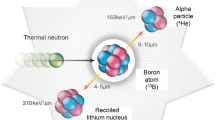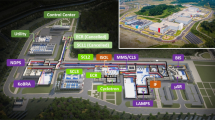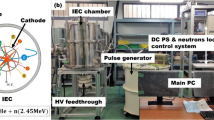Abstract
Purpose
In this paper we compare the main AB-BNCT facilities worldwide in terms of neutron-producing nuclear reactions, existing technologies and machines, and induced radioactivity both at the target and at the beam shaping assembly (BSA) level, by the resulting neutron beam. We also provide information on several aspects of the Buenos Aires project.
Methods
A comparison is made of the different active AB-BNCT projects and facilities worldwide using the information available in the literature. The radioactivity induced by both the direct beams (protons or deuterons) at the targets (7Li, 9Be and 13C) and the neutron beams at the BSAs is discussed. The main technical features of the Argentina project are presented.
Results
There are a number of different facilities for Accelerator-Based BNCT (AB-BNCT) worldwide, some already working and even treating patients and some under development and construction. They range from high-energy 30 MeV cyclotrons (using the 9Be(p,n) reaction), medium-energy RFQ-DTL accelerators (at 8 and 10 MeV using likewise the 9Be(p,n) reaction), low-energy electrostatic, both Tandem and single-ended, and RFQ machines (working on 7Li(p,n) at about 2.5 MeV), to a very low-energy single-ended electrostatic quadrupole accelerator, ESQ (working on 9Be(d,n) or 13C(d,n) at 1.45 MeV). This last accelerator, its ancillary systems and the associated facility is being developed and constructed at the National Atomic Energy Commission of Argentina. An important aspect about these facilities, relevant for their long term sustainability, is the production of radioactivity, which should be kept at a minimum according to the ALARA criterium, both at the neutron production target, by the primary beam, and at the Beam Shaping Assembly (BSA), by the induced neutrons. In a 30 day period with an operation schedule of 8 h a day the 7Li(p,n) at 2.3 MeV option produces 2.1 TBq of 7Be (30 mA), the Be(p,n) option at 8 MeV only produces prompt radiation while at 30 MeV (1 mA) other reaction channels are open which produce 0.39 TBq of 7Be and 4.2 GBq of 3H. The 13C(d,t) reaction produces 0.78 GBq of 3H.
Conclusions
The use of exothermal deuteron-induced Be(d,n) and 13C(d,n) reactions allows us to use the smallest energy machine, at 1.45 MeV, for AB-BNCT. It is shown that among the systems proposed the 13C(d,n) solution is the one with the lowest overall activation (target + BSA). Coupled to an AlF3 BSA (which undergoes no long term activation), a 30 mA deuteron beam on a 13C target can deliver a good quality BNCT treatment for a deep seated brain tumor in one hour.







Similar content being viewed by others
Availability of data and material
No data associated with this paper.
Code availability
No codes associated.
References
Advances in boron neutron capture therapy / International Atomic Energy Agency. ANNEX II. P. 255. IAEAL 23–01601 | ISBN 978–92–0–132723–9. ISBN 978–92–0–132623–2.
Advances in boron neutron capture therapy / International Atomic Energy Agency. ANNEX III.P. 261. IAEAL 23–01601 | ISBN 978–92–0–132723–9. ISBN 978–92–0–132623–2.
Advances in boron neutron capture therapy / International Atomic Energy Agency. ANNEX IV.P. 269. IAEAL 23–01601 | ISBN 978–92–0–132723–9. ISBN 978–92–0–132623–2.
Advances in boron neutron capture therapy / International Atomic Energy Agency. ANNEX VI.P. 301. IAEAL 23–01601 | ISBN 978–92–0–132723–9. ISBN 978–92–0–132623–2 and references therein.
Kreiner AJ, Kwan JW, Burlon AA, et al. A Tandem-ESQ for Accelerator-Based Boron Neutron Capture Therapy. NIM B. 2007;261:751–4.
Kreiner AJ, et al. Present status of Accelerator-Based BNCT. Reports of Practical Oncology and Radiotherapy. 2016;21:95–101.
Advances in boron neutron capture therapy / International Atomic Energy Agency. ANNEX XI. P.337. IAEAL 23–01601 | ISBN 978–92–0–132723–9. ISBN 978–92–0–132623–2.
Advances in boron neutron capture therapy / International Atomic Energy Agency. ANNEX VIII .P.313. IAEAL 23–01601 | ISBN 978–92–0–132723–9. ISBN 978–92–0–132623–2.
Advances in boron neutron capture therapy / International Atomic Energy Agency. ANNEX IX .P.323. IAEAL 23–01601 | ISBN 978–92–0–132723–9. ISBN 978–92–0–132623–2.
Advances in boron neutron capture therapy / International Atomic Energy Agency. ANNEX VII .P.307. IAEAL 23–01601 | ISBN 978–92–0–132723–9. ISBN 978–92–0–132623–2.
Capoulat ME, Minsky DM and Kreiner AJ. Computational assessment of deep-seated tumor treatment capability of the 9Be(d,n)10B reaction for AB-BNCT, Physica Medica. Europ J Med Phys. 2014;30:133–146.
Capoulat ME, Kreiner AJ. A 13C(d, n)-based epithermal neutron source for BNCT. Phys Med. 2017;33:106–13.
Capoulat ME, et al. Neutron spectrometry of the Be(d(1.45MeV),n) reaction for AB-BNCT, NIM B445. 2019;57.
Capoulat ME, Kreiner AJ. Induced radioactivity in AB-BNCT: an analysis of the different facilities worldwide. Front Nucl Eng. 2023;2:1275396. https://doi.org/10.3389/fnuen.2023.1275396.
Bertolo AA, et al. Manufacture, characterization, and proton irradiation effects of 12C and 13C thick targets. J Mater Sci. 2021;56:6997–7007. https://link.springer.com/article/10.1007/s10853-020-05728-7.
Gagetti L, et al. Proton irradiation of beryllium deposits on different candidate materials to be used as a neutron production target for accelerator-based BNCT. Nuclear Inst. and Methods Phys Res A 2017;874:28–34.
Funding
This work was funded by Comisión Nacional de Energía Atómica of Argentina.
Author information
Authors and Affiliations
Corresponding author
Ethics declarations
Conflicts of interest
No conflicts of interest nor competing interests to report.
Additional information
Publisher's Note
Springer Nature remains neutral with regard to jurisdictional claims in published maps and institutional affiliations.
This article is part of the Hadrontherapy and BNCT: Current Status and Future Trends
Rights and permissions
Springer Nature or its licensor (e.g. a society or other partner) holds exclusive rights to this article under a publishing agreement with the author(s) or other rightsholder(s); author self-archiving of the accepted manuscript version of this article is solely governed by the terms of such publishing agreement and applicable law.
About this article
Cite this article
Capoulat, M.E., Cartelli, D., Baldo, M. et al. Accelerator-based neutron sources for BNCT. Health Technol. (2024). https://doi.org/10.1007/s12553-024-00829-8
Received:
Accepted:
Published:
DOI: https://doi.org/10.1007/s12553-024-00829-8




